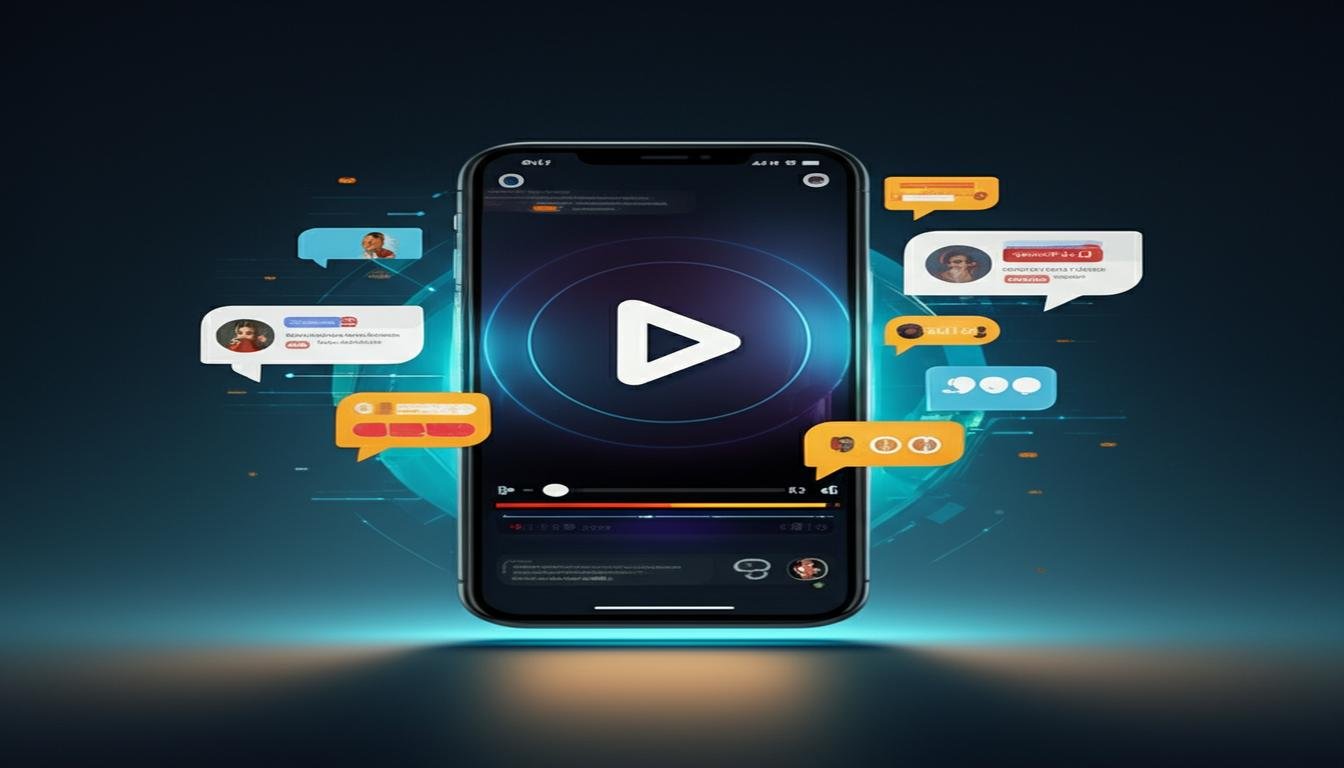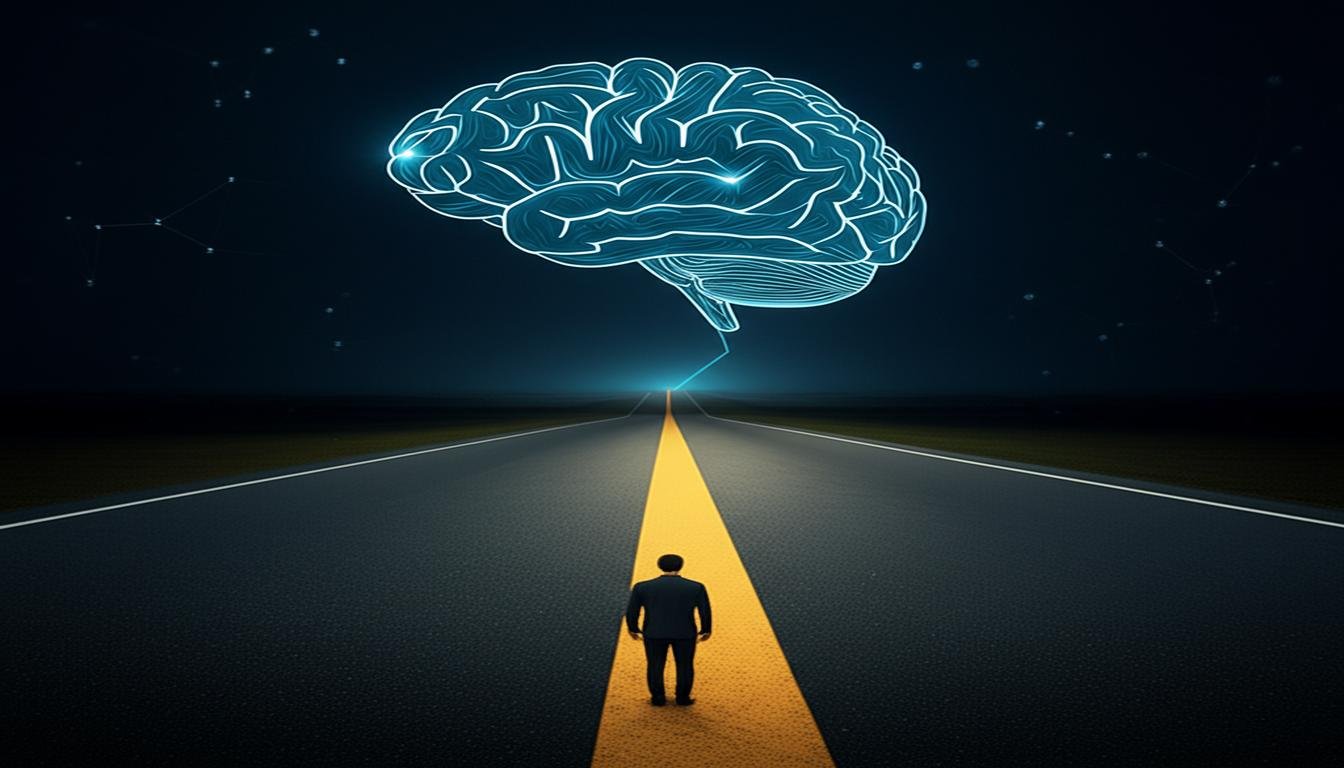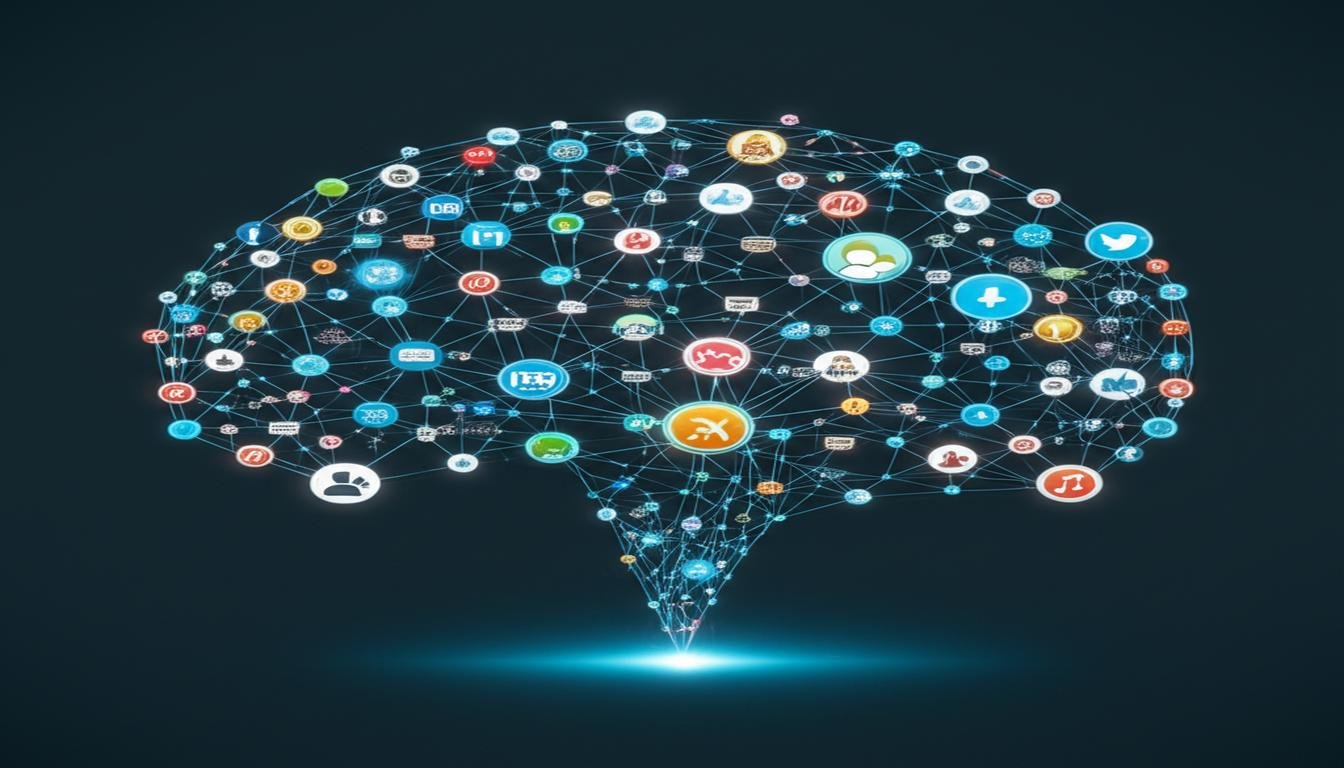63% of tech leaders in a Pew Research survey say AI-driven decision-making could take over key human systems by 2030. This includes things like healthcare and criminal justice. It shows why we need to understand artificial intelligence and the future of humans now, not later.
Forbes Council analysts call today’s AI advancements a “double-edged scalpel”. They can be precise, like IBM’s Watson in healthcare, or sharp, like Neuralink’s neural interfaces. Almost 1,000 experts agree we’re at a turning point. Machine learning could boost human abilities or make us too dependent on it.
This isn’t just a debate. There are real examples of AI’s impact:
- Medical AI can spot cancers months before humans can
- Brain-computer interfaces can help people move again but raise privacy issues
- Autonomous weapons systems are making us rethink ethics worldwide
Table of Contents
Key Takeaways
- More than 60% of experts think AI will change society a lot by 2030
- AI is already changing healthcare and criminal justice
- Brain-machine interfaces show both hope and danger
- Ethics are falling behind tech
- We need to act fast to protect jobs
The Current State of Artificial Intelligence
Artificial intelligence has grown from just ideas to real tools changing how we work and live. Businesses and governments are using these systems more than ever. This brings new powers and also raises big questions about society.
Breakthroughs in Machine Learning
Today’s AI focuses on transformer architectures for better handling of sequential data. These advancements power tools like GPT-4o, which can understand text, voice, and images like a human. Three major achievements are:
- Multimodal learning systems analyzing 5+ data types at once
- Cost-efficient models like DeepSeek cutting cloud computing costs by 70%
- Anthropic’s Claude scoring 89% in legal contract analysis
These advancements bring us closer to sci-fi dreams. IBM says 42% of companies use machine learning now, with healthcare and finance leading the way. NVIDIA’s tools can make marketing content 8 times faster than people, showing big productivity gains.
Real-World Applications Today
AI is changing the world, but it also brings up big questions. Here are some examples:
| Industry | Application | Impact |
|---|---|---|
| Healthcare | AI diagnostics matching radiologists’ accuracy | 30% faster cancer detection |
| Agriculture | John Deere Smart Harvesters | 20% yield increase |
| Public Safety | Facial recognition systems | 65% crime reduction in pilot cities |
These tools make things more efficient, but they also raise privacy concerns. China’s social credit system shows how AI can shape our behavior. It’s important to use these technologies wisely, balancing progress with ethics.
Retailers use AI for better shopping experiences, and manufacturers check quality automatically 43% of the time. The key is to use AI in ways that help people, not just replace them.
Artificial Intelligence and the Future of Humans
Ray Kurzweil predicts human-level AI by 2029. This makes us think about societal shifts happening fast. It’s just six years until AI could change work, creativity, and our purpose.
We’re not racing against machines, we’re racing with machines.
This quote shows the big debate in AI. Some think AI will:
- Find cures for rare diseases in months, not decades
- Predict weather with 95% accuracy
- Personalize education for each student in real-time
But others worry about:
- AI taking many jobs
- AI making social problems worse
- AI making decisions without being accountable
Dario Amodei talks about “compressed innovation.” This means changes could come fast. When AI gets better at improving itself:
- Drug discovery goes from 10 years to 10 months
- Software development gets 400% faster
- Scientific paper analysis takes minutes, not semesters
This fast pace creates a problem. AI could solve big issues like climate change or cancer. But it might also make jobs unstable before we can fix it. The U.S. needs to change healthcare and education fast to keep up with AI.
You have a role in this future. Whether you’re working in supply chains or teaching, knowing about AI helps. It lets you:
- Find skills that are important even with automation
- See the risks in AI’s decisions
- Use tools that help, not replace, human thinking
The next decade is about working with AI, not against it. It’s called “the augmented age.” To succeed, we need to understand AI well and think deeply about its impact. We’ll dive into this more in the next sections.
Also Read: Exploring the Role of AI in the Modern Workforce
Technological Foundations Shaping AI Development
Modern AI is changing fast thanks to quantum physics and neural science. Big names like Google and IBM are pushing the limits of what computers can do. At the same time, DeepMind and Neuralink are exploring new ways to make AI work like our brains. These leaps forward open up new possibilities but also raise important questions about ethics.
Quantum Computing’s Role
Google showed in 2019 that quantum computers can do things classical computers can’t. They solved a problem in 200 seconds that would take a supercomputer 10,000 years. Now, IBM is working with big drug companies to make finding new medicines faster:
- Molecular simulations are now 100x faster than before
- Quantum computers help solve big problems in vaccine distribution
- They can predict how proteins fold with great accuracy
This table shows how quantum computers are changing medical research:
| Aspect | Quantum Computing | Classical Computing |
|---|---|---|
| Processing Speed | Minutes for complex models | Weeks for equivalent tasks |
| Optimization Capability | Multi-variable solutions | Single-variable focus |
| Security Risk | Potential decryption threats | Established protections |
Experts say quantum computers could break current encryption. This means we need to work on post-quantum cryptography to stay safe.
Neural Network Innovations
DeepMind’s AlphaFold 3 can predict protein structures with 95% accuracy. Neuralink is also making progress, showing that we can turn thoughts into text in real time.
Three big breakthroughs are driving this progress:
- Neuromorphic chips that mimic the brain
- Models that use less energy to transmit signals
- Systems that learn and adapt quickly
Kernel’s neural prosthetics let paralyzed people control digital devices. But, there are worries about fairness and who gets to use these technologies.
We’re not just building smarter machines – we’re redefining what it means to be human in the digital age.
As these technologies get better, we need to make sure they help everyone. Policymakers have to balance encouraging innovation with making sure no one is left behind.
Ethical Considerations in AI Implementation
Artificial intelligence is now a big part of our lives, and we need to think about its ethics. Two big problems are algorithmic bias in decision-making systems and privacy risks from new surveillance tech. These issues affect how much we trust AI and whether it helps or hurts society.
Algorithmic Bias Challenges
AI systems can reflect our own biases, hidden in the data they learn from. For example, Amazon’s tool once unfairly judged resumes with certain words. The FTC looked into OpenAI’s ChatGPT in 2023 and found it could suggest discriminatory housing options.
To fight bias, we need:
- Diverse training data that shows the real world
- Tools like IBM’s AI Fairness 360 to find bias
- Transparency checks under the EU AI Act
Bias isn’t a technical glitch – it’s baked into systems through incomplete data and homogeneous development teams.
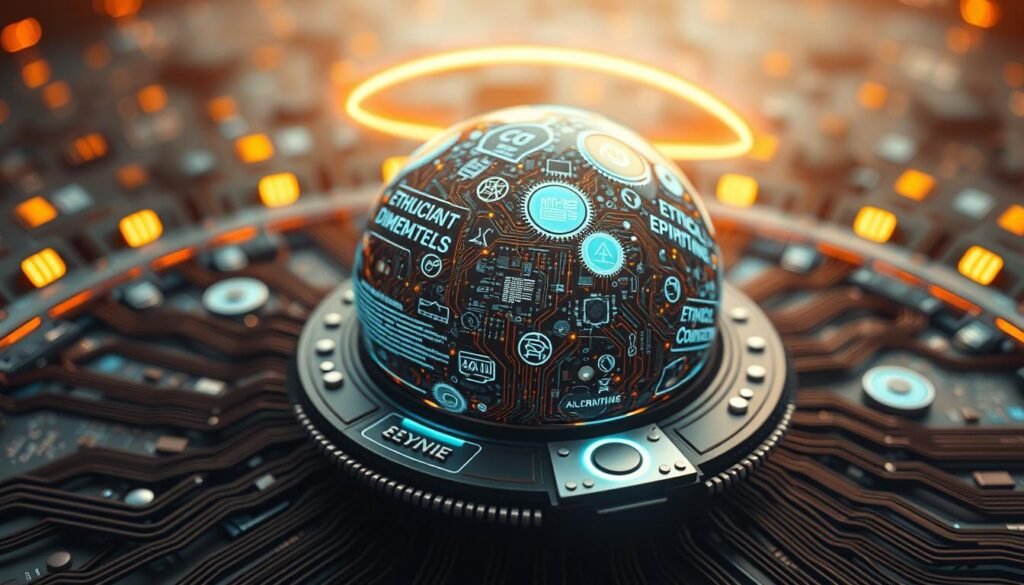
Privacy Concerns in Surveillance Systems
Facial recognition tech, like Clearview AI, has raised big questions by using 3 billion social media photos without asking. In Singapore, the TraceTogether app during COVID-19 showed how to balance privacy with public health. Most people agreed to its temporary data retention policy.
Here are some ways to solve privacy issues:
- Differential privacy adds “noise” to data
- Biometric databases need strict access
- Emergency surveillance systems should have sunset clauses
The Electronic Privacy Information Center (EPIC) recently won a big case against police face scans without warrants. This shows the need for privacy-first architectures in AI. Developers must protect our rights while keeping us safe.
Workforce Transformation Through Automation
The rise of artificial intelligence is changing jobs faster than the steam engine changed factories in the 19th century. Automation brings new chances but also takes away old jobs at a huge scale. PwC research shows 44% of workers might see big job changes by the mid-2030s. This means both workers and employers need to adapt quickly.
Manufacturing Sector Disruption
Foxconn replaced 400,000 jobs with robots in 2022, showing AI’s big impact on manufacturing. Modern factories, like Siemens’ digital twin facilities, use IoT sensors and machine learning. They:
- Predict equipment failures 72 hours in advance
- Optimize production lines in real-time
- Reduce material waste by 19% annually
This change is like the 20th-century shift to mechanized farming but is happening much faster. Udacity CEO Sebastian Thrun says:
The next billion displaced workers won’t have generations to adapt – reskilling must happen in months, not decades.
White-Collar Job Evolution
AI now handles 78% of document review in top law firms, McKinsey reports. But, Brookings Institution data shows a problem. While output goes up, the gap between AI-augmented specialists and generalists grows.
New hybrid roles show how people are adapting:
| Traditional Role | AI-Enhanced Position | Skills Added |
|---|---|---|
| Data Entry Clerk | AI Training Specialist | Machine Learning Validation |
| HR Recruiter | Talent Analytics Manager | Predictive Hiring Algorithms |
IBM’s SkillsBuild has retrained 300,000 workers on working with AI. Upwork’s job listings show a big increase in demand for “AI handlers” who know both tech and operations.
Human-Machine Collaboration Frontiers
Imagine your phone knowing what you need before you even look at your calendar. This idea is at the heart of today’s human-machine collaboration advancements. It combines our natural instincts with the power of algorithms. We’re seeing big changes in how humans and machines team up, from surgeons using augmented reality to programmers working with AI tools.
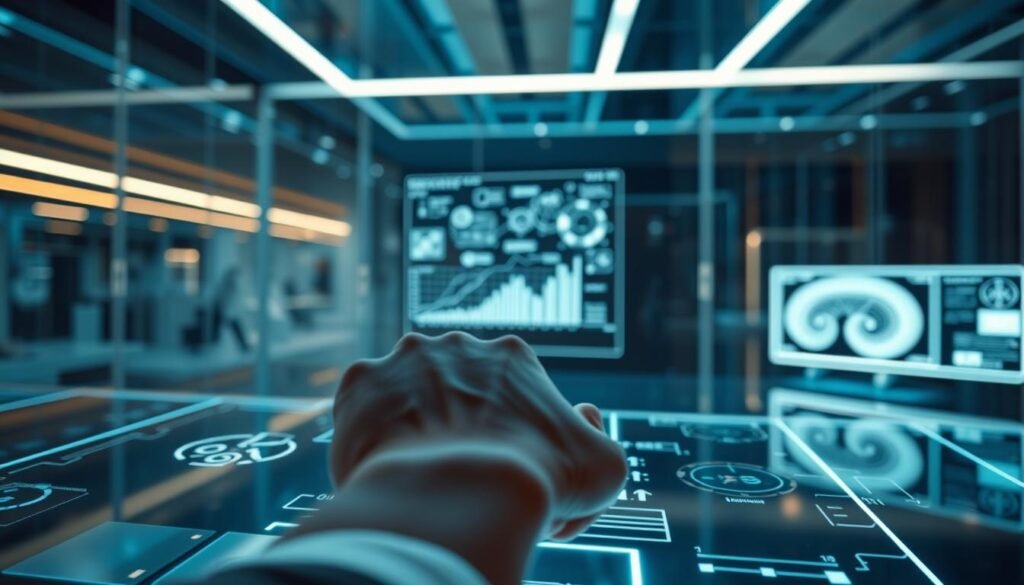
Augmented Intelligence Systems
Augmented intelligence doesn’t replace human thinking; it boosts it. Johns Hopkins’ AR platform for surgery is a great example. It helps surgeons see 3D organ maps in real-time, cutting down operation times by 27%. These systems are great at three main things:
- Decision acceleration: Microsoft Copilot reduces coding mistakes by 31% while keeping control with developers
- Pattern recognition: DeepMind’s AlphaCode finds software bugs that humans often miss
- Cognitive offloading: FAA’s NextGen system handles 78% of routine air traffic decisions
We’re not building machines to think for us – we’re creating partners that help us think better.
Brain-Computer Interface Developments
The gap between our minds and machines is shrinking fast. Neuralink’s FDA-approved trials have shown promising results in restoring motor function in paralysis patients. Kernel’s non-invasive headsets can track neural activity with 94% accuracy. Recent breakthroughs highlight three key areas:
| Technology | Capability | Impact |
|---|---|---|
| Paradromics implants | 4,096 electrode channels | High-speed thought translation |
| Duke encryption | Neural signal scrambling | Prevents mind hacking |
| Kernel Flow | Wireless monitoring | Real-time focus tracking |
But there are big ethical questions in this ai and human evolution area. Duke University’s work on thought encryption tackles the issue of neurosecurity. As these technologies get better, they’ll change many areas, from education to emergency responses.
Healthcare Revolution via AI Diagnostics
Modern medicine is changing fast, thanks to ai technology advancements. These changes are making healthcare better in many ways. They help doctors find and treat illnesses more accurately.
Early Disease Detection Systems
AI tools can spot diseases months before old methods can. For example, PathAI’s system finds cancer cells with 97.6% accuracy. This is better than human doctors in some cases.
Three big advances are making early care possible:
- RetinaScan’s diabetic retinopathy detection (94% sensitivity)
- Viz.ai’s stroke recognition software (reduces diagnosis time by 68%)
- Butterfly Network’s handheld ultrasound with AI interpretation
The WHO has updated guidelines for medical images to include AI checks. But, there are questions about who’s to blame if AI misses something. The FDA has rules to help with these issues.
| Diagnostic Method | Accuracy | Speed | Cost |
|---|---|---|---|
| Traditional Pathology | 92.4% | 48-72 hrs | $150-300 |
| AI-Assisted Analysis | 97.1% | 2-4 hrs | $80-120 |
| Combined Approach | 98.9% | 6-8 hrs | $130-200 |
Surgical Robotics Advancements
Robotic systems are making surgery better, everywhere. Intuitive Surgical’s da Vinci SP lets doctors do surgery through one small opening. Medtronic’s Hugo RAS is 40% faster than older models.
Three big steps are making surgery better for everyone:
- 5G-enabled telesurgery platforms allowing remote operations
- Autonomous suturing prototypes achieving 99% stitch consistency
- Haptic feedback systems replicating human touch sensitivity
The AMA now requires doctors to do 200+ robotic surgeries before they can work alone. This is a big change. Studies show a 63% drop in complications after surgery.
| System | Procedures Supported | Learning Curve | Success Rate |
|---|---|---|---|
| da Vinci SP | Urology, Gynecology | 50-70 cases | 98.2% |
| Hugo RAS | General Surgery | 30-50 cases | 96.8% |
| Versius | Orthopedics | 40-60 cases | 95.4% |
AI is changing healthcare, not replacing doctors. It’s making them better by working with them. As rules catch up, patients will get better care sooner and more accurately.
Autonomous Systems Reshaping Transportation
Imagine cars driving themselves on roads and drones flying in the sky for delivery. This isn’t just science fiction anymore. Autonomous systems are changing how we move, making roads safer and delivery faster. But, they also raise important questions about our infrastructure and rules.
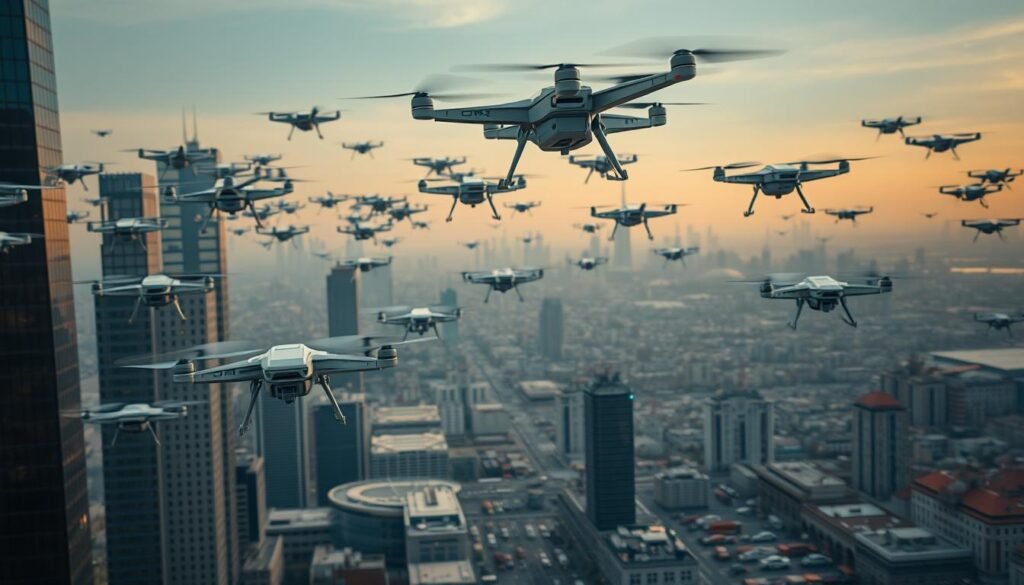
Self-Driving Vehicle Progress
Waymo’s self-driving cars have driven over 20 million miles on public roads. This shows how fast AI navigation is improving. Tesla’s Full Self-Driving system now works better, with a 300% improvement in 2021.
These advancements use sensor fusion technology. It combines lidar, cameras, and radar to understand the world around it.
Mercedes’ Drive Pilot is the first SAE Level 3 system approved for U.S. highways. It lets drivers relax in traffic jams. But, there are challenges:
- AI systems can get confused by sudden weather changes
- NHTSA now requires crash reports for all autonomous vehicle incidents
- Many people don’t fully trust these new technologies
Drone Delivery Networks
Zipline’s drones in Rwanda deliver blood in just 30 minutes. This model is now coming to U.S. healthcare. Amazon Prime Air made its first prescription delivery in Texas last month, cutting delivery times from days to hours.
These systems use AI-powered route optimization. They consider weather, obstacles, and air traffic.
Wing’s COVID-19 vaccine deliveries showed drones’ role in emergencies. But, there are big challenges to overcome:
| Benefit | Challenge |
|---|---|
| 90% lower emissions than trucks | Noise complaints in residential areas |
| 30% cost reduction for last-mile delivery | FAA’s UTM system is in testing phase |
The FAA’s new Unmanned Traffic Management system worked well in recent trials. It coordinated 1,200 drones at once. As these systems grow, they’ll change cities and what we expect from delivery.
Environmental Impact of AI Solutions
Artificial intelligence is a double-edged sword in the fight against climate change. On one hand, AI technology advancements bring us powerful tools for the environment. On the other, they require a lot of energy. Innovators are working to find a balance by improving climate predictions and energy systems.
Climate Modeling Improvements
NVIDIA’s Earth-2 project shows AI can predict weather extremes much faster than before. It uses CMIP6 climate data to forecast floods with high accuracy in South Asia. Boston Metal also uses AI to make carbon capture systems more efficient, reducing emissions by 40% in tests.
But, training these models uses a lot of energy, enough to power 1,200 homes a year. Some argue it’s worth it to prevent climate disasters. Yet, it raises questions about the sustainability of AI. A climate scientist said:
We’re using tomorrow’s technology to fix yesterday’s mistakes, but we need circular solutions.
Energy Optimization Systems
Google DeepMind’s AI cut data center cooling costs by 40% with smart temperature controls. AutoGrid’s AI helps balance energy from solar and wind in Texas neighborhoods. Nest’s Rush Hour Rewards program uses AI to:
- Shift appliance use during peak demand
- Reduce household energy bills by 15%
- Prevent grid overloads during heatwaves
But, there’s a risk of using more energy because of these gains. Smart grids help cut CO2 emissions by 2.3 million tons a year. Yet, data center emissions are as big as the aviation industry’s. We need to pair AI technology advancements with green energy to ensure a sustainable future for everyone.
Educational Transformation Through Adaptive Learning
Artificial intelligence is changing education, making learning fit each student’s needs and preparing them for the job market. Adaptive learning technologies connect classroom learning to real-world skills. They help solve ai future trends and ai job displacement issues.

Tailoring Education to Individual Potentials
Platforms like Duolingo and Coursera show AI’s power to make learning personal. Duolingo uses AI to adjust language lessons based on how you speak. Coursera suggests courses based on job trends:
- Knewton’s adaptive learning cuts course times by 25% by focusing on what you know
- Squirrel AI’s tutors adjust lessons to fit your mood while keeping your privacy
- SpaceX’s Starlink brings AI tutors to remote Alaskan villages
These systems make learning fair and keep your privacy safe. An educational tech expert says:
The best AI tutors don’t replace teachers – they enhance teaching with data insights.
Closing the Skills Divide
AI helps bridge the skills gap in the workforce. LinkedIn tracks skills in real-time. IBM SkillsBuild predicts career paths:
| Platform | Core Technology | Impact |
|---|---|---|
| Burning Glass APIs | Labor market analytics | Matches 93% of training to local job openings |
| Walmart Live Better U | Adaptive reskilling paths | 75% program completion rate |
| MIT Skills Network | Blockchain credentialing | Reduces hiring mismatches by 40% |
Some worry AI limits career choices. But Walmart’s success shows humans are in control. People moving from cashier to IT jobs see a 142% salary boost. This shows AI can boost careers when used right.
Economic Shifts in the AI-Driven Era
Artificial intelligence is changing the world of work and the global economy. It’s creating new billion-dollar companies and sparking debates on fair resource use. This shift is bringing both opportunities and challenges for businesses and individuals.
New Market Creation
AI is like a digital alchemist, turning data into new industries. For example, the computational pharmacology sector is growing fast, valued at $4.9 billion in 2024. Companies like Insilico Medicine use AI to speed up drug discovery, making treatments available much faster.
AI is creating three new markets:
- Synthetic media: Expected to grow 34% each year until 2030, making personalized content easier
- Generative design: AI is making manufacturing more efficient, cutting waste by 40%
- Predictive maintenance: A $23 billion market that helps prevent equipment failures
But, fast growth also brings risks. In 2023, AI startups got $42 billion in funding, leading to valuation bubbles. NVIDIA’s CEO, Jensen Huang, notes that the difference between real innovation and hype is often clear later.
Wealth Distribution Challenges
AI creates a lot of value, but it’s not shared equally. The top 1% have grabbed 38% of AI-related wealth growth from 2020. This is due to platform economies where a few giants, like Meta and Google, dominate despite many competitors.
| Solution | Key Feature | Implementation | Impact |
|---|---|---|---|
| Universal Basic Income | Monthly cash payments | Finland’s pilot reduced stress by 37% | Addresses basic needs |
| Worker Ownership | Employee stock plans | Spanish tech cooperatives | Boosts retention by 41% |
| Philanthropic Funds | Billionaire pledges | Bezos Earth Fund | Funds climate tech |
Economists have different views on how to fix this. Thomas Piketty suggests taxing AI patent holders, while Microsoft’s Brad Smith supports retraining workers. The challenge is finding a balance between innovation and social stability.
As AI changes the economy, our choices will shape its impact. Will we create a fair growth model, or follow old patterns of inequality? The answer will affect our future for generations.
Policy Development for AI Governance
Artificial intelligence is changing many industries, and governments must balance innovation with safety. They need to create AI policies that work for all industries and for new technologies. This means making rules for specific areas like healthcare and broad rules for all uses.
US Regulatory Frameworks
The Biden administration’s 2023 AI Executive Order was a big step. It asked federal agencies to:
- Use the NIST AI Risk Management Framework for public projects
- Set safety standards for AI in critical areas
- Make algorithms more transparent
Regulators are taking different paths in different areas. The FDA looks at AI tools in healthcare, while the FTC checks for bias in lending. Colorado’s AI Insurance Act shows how states can lead with new ideas, like regular checks on AI systems.
But there are big challenges:
- Keeping up with new AI while ensuring safety
- Getting federal and state rules to work together
- Dealing with how AI changes jobs
International Collaboration Efforts
World leaders know AI needs global cooperation. The EU’s AI Act sets a risk level for AI, from unacceptable to minimal risk. Also, 46 countries follow the OECD’s AI Principles, setting ethical standards.
Some key efforts include:
| Initiative | Members | Focus Area |
|---|---|---|
| Global Partnership on AI | 29 nations | Responsible AI research |
| UN AI Advisory Body | 38 experts | SDG alignment |
| China’s AI Governance Committee | 15 ministries | Domestic standard-setting |
Different views on AI create challenges. The West focuses on individual rights, while China puts state security first. Finding common ground is key, as AI like facial recognition spreads worldwide. The IEEE’s Ethically Aligned Design offers a way forward, but political support is needed.
Artificial Intelligence and Human Evolution
Humanity is at a turning point, where biology meets technology. AI is changing how we evolve. It brings new chances to improve us but also raises big questions about who we are and what’s right.
Cognitive Enhancement Possibilities
New projects are changing how we think. Neuralink’s N1 implant could make our memory 40% better, based on early tests. DARPA’s N3 program lets soldiers control drones with their minds.
At USC and University of Miami, scientists have made big strides:
- AI helps us learn 25% faster
- It improves memory in Alzheimer’s patients
- It makes us better at making tough decisions
Cognitive enhancement technologies force us to confront fundamental questions about what it means to be human.
But, there’s a worry about who can get these upgrades. Catalyst Partners wants to make sure everyone has access. They plan to:
- Make neural interfaces affordable
- Set global rules for brain upgrades
- Teach people about the risks
Biological Integration Technologies
The line between humans and machines is blurring. Synchron’s Stentrode connects our brains directly. Wyss Center is working on AI and biology together.
| Technology | Purpose | Current Stage |
|---|---|---|
| Neuralink N1 | Motor function restoration | Human trials |
| ONWARD ARC Therapy | Spinal injury recovery | FDA-approved |
| Wyss Organoids | Neural network modeling | Lab research |
ISSCR has rules for mixing biology and tech:
- Keep our consciousness safe
- Avoid bad side effects
- Let us make our own choices
ONWARD Medical’s ARC Therapy has helped patients a lot. It shows how careful tech can help us. As we move forward, we must think about what it means to be human.
Predicting Future AI Development Trajectories
AI systems are getting smarter, and it’s important to know how they might change. This part looks at two big areas: the search for general AI and advances in humanoid robots.
General AI Prospects
Current AI systems are great at specific tasks, like understanding language or recognizing images. But making machines that can think like humans in many ways is a huge challenge. DeepMind’s Gato can do over 600 tasks, showing what might be possible in the future.
But, some question if these systems really get what’s going on or just follow patterns. Anthropic’s Constitutional AI tries to make sure AI acts ethically. OpenAI’s Preparedness Framework focuses on keeping AI safe after it’s made.
Important things to think about include:
- How to make AI truly conscious
- Keeping complex AI systems from using too much energy
- Creating safety rules for AI that can improve itself
Humanoid Robotics Timeline
In 2023, the push to make humanoid robots got a lot faster. Boston Dynamics’ Atlas can now do parkour, and Tesla’s Optimus can pick up objects with precision. BMW teamed up with Figure to test humanoid robots in factories, aiming to make dangerous jobs safer.
There are three big hurdles for developers:
- Getting robots to feel less creepy in caregiving roles
- Improving battery life for robots that move around
- Making robots affordable compared to human workers
Apptronik’s Apollo system shows how AI is getting better at working in the real world. As these technologies get better, expect humanoid robots to take on complex jobs by 2030. They might help in hospitals or during emergencies.
Case Studies: AI’s Real-World Impacts
Artificial intelligence is changing the game in many fields. Let’s look at two examples that show what artificial intelligence can do today. They also show the impact of AI on society.
IBM Watson Oncology: From Lab to Hospital
IBM Watson teamed up with MD Anderson Cancer Center. It looked at 25,000 patient records to find patterns in treatments. Early tests showed it matched human doctors 90% of the time for lung cancer.
But the real test was at Memorial Sloan Kettering:
- Reduced treatment planning time by 78% for complex cases
- Identified rare therapy options in 30% of late-stage patients
- Faced 42% clinician resistance due to “black box” decision-making
Watson excels at pattern recognition but struggles with contextual nuance – like a patient’s financial constraints or cultural preferences, notes Dr. Lisa Patel from Johns Hopkins.
Watson got better with updates using federated learning. It can now look at data from 14 hospitals without sharing personal info. This helped find rare cancers 19% more often in 2023 trials.
John Deere’s Smart Harvesters: Farming Revolution
The See & Spray system uses computer vision to spot weeds with 98% accuracy. It was launched in 2021 and has seen 200% growth in adoption among big farms:
| Metric | Pre-AI (2020) | Post-AI (2023) |
|---|---|---|
| Herbicide Use | 100% coverage | Targeted 23% |
| Yield per Acre | 178 bushels | 204 bushels |
| Labor Hours | 60/week | 42/week |
But, the United Farm Workers say 15% fewer jobs in California’s Central Valley. Small farms struggle too – only 12% can afford the $300,000 systems. This creates a gap in technology that’s changing rural economies.
These examples show AI’s two sides. They show artificial intelligence’s current capabilities. But they also show we need to think about how it affects jobs and who can use it.
Conclusion
The link between artificial intelligence and our future is both promising and complex. Pew Research Center found 52% of Americans are hopeful about AI’s problem-solving skills. IBM’s Global AI Adoption Index shows 42% of companies use AI for automation.
This data highlights how fast technology is changing our work, healthcare, and daily lives. It shows AI’s growing impact.
It’s important to have good governance to balance innovation with ethics. The European Union’s AI Act sets rules for biometric systems. The US National AI Initiative Act funds responsible AI development through groups like NIST.
These efforts show how policy can help AI and humans have a fair future.
Real-world examples show teamwork leads to success. IBM Watson Oncology helps doctors in 13 countries with treatment plans. John Deere’s AI harvesters cut farm waste by 15%.
These examples highlight how AI can help, not just replace humans.
UNESCO’s AI Ethics Recommendation calls for inclusive design. As AI and quantum computing advance, keeping public trust is key. We need ongoing talks between tech experts, policymakers, and communities.
What part will you play in shaping AI and our future? You can help by creating ethical algorithms, making smart laws, or staying updated on new tech. Every voice counts in this evolving story.
FAQ
How is artificial intelligence currently being used in healthcare?
AI is changing healthcare fast. IBM Watson Oncology helps doctors find the best treatments. Viz.ai’s tools quickly spot strokes. RetinaScan can spot diabetes early with just a scan of your eyes.
What safeguards exist against algorithmic bias in AI systems?
IBM’s AI Fairness 360 toolkit helps find and fix bias in AI. The EU wants to make sure AI is fair and open. Anthropic’s Constitutional AI shows how to make AI fair and explainable.
How will quantum computing accelerate AI development?
Quantum computers like Google’s Sycamore are getting better fast. Boston Metal uses quantum to make new materials quickly. But, we need to make sure our computers stay safe from quantum threats.
Are brain-computer interfaces like Neuralink safe for human use?
Brain-computer interfaces are promising, but they need careful testing. Kernel’s helmets might help us remember better. But, we must make sure they’re safe and don’t change our brains too much.
What jobs are most vulnerable to AI automation?
AI might take over some jobs, like in factories. Siemens is already using AI to make things better. But, AI can also help people learn new skills, like making AI trainers.
How does AI improve climate change modeling?
AI makes climate modeling faster and more accurate. NVIDIA’s Earth-2 supercomputer is a big help. But, making AI work fast uses a lot of energy, which is a problem.
Can AI address educational disparities in rural areas?
Yes, AI can help students in remote areas. SpaceX and Knewton are working on math lessons for Alaska. But, we need to make sure AI doesn’t make things worse for some students.
What regulations govern autonomous vehicle safety?
The US and California have rules for self-driving cars. Tesla and Mercedes must report when their cars stop driving. Waymo must be ready to react fast in cities.
How does AI impact pharmaceutical development?
AI can speed up finding new medicines. Insilico Medicine made a drug in just 23 months. But, the FDA wants to make sure these new medicines are safe and work well.
What ethical concerns surround military AI applications?
Using AI in war raises big questions. The UN is worried about drones that can attack on their own. China’s Social Credit System uses AI to control people, which is a big privacy issue.










